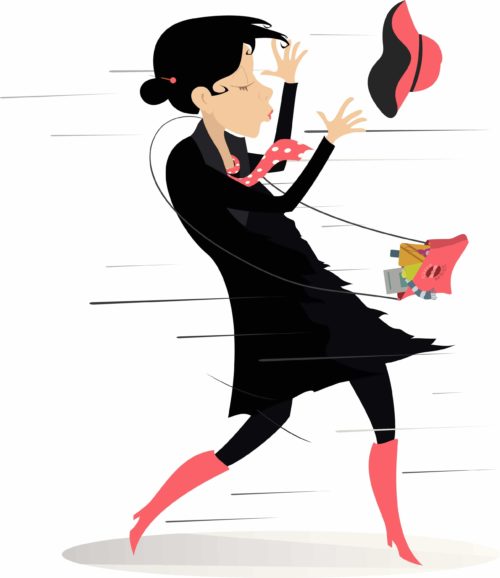
The Power of Positive Air Pressure
Imagine this: It’s a sweltering summer day and you’re out running errands. You have to park way out in the giant parking lot. By the time you’ve trudged all the way across the steaming asphalt to get to your favorite big-box store you’re dripping with sweat.
You feel like you’re just about to melt when the automatic doors whoosh open and a blast of icy cold air hits you before you’ve even gotten inside. And just like that, you’re no longer in danger of turning into a puddle on the sidewalk like Frosty on a sunny day.
It’s the best, isn’t it? But have you ever wondered why the air comes blowing out like that? Or why stores would want to set up their HVAC system so that it seems to be wasting energy cooling people on the sidewalk?
See Also: Why You Need a Duct Pressure Test
Positive Air Pressure Keeps Outside Air Out
The secret is that those stores aren’t wasting energy at all. Instead, they’re taking advantage of the power of positive air pressure. You see, most commercial buildings are designed to be under positive pressure, meaning that the air pressure inside of the building is higher than the air pressure outside.
But why would they want all that cold air blowing out every time the doors open?
- It’s better than the alternative, which is hot and humid air coming in.
- By keeping the building at a slightly positive air pressure, the HVAC system is constantly pushing air outward. I
- If the building were at a negative pressure instead, it would act like a vacuum, constantly sucking air into the building from outside.
In that case, every time the door opened for a customer, hot and humid air would get pulled into the store.
High humidity can cause a lot of problems.
- It makes warm temperatures feel even warmer.
- With lower humidity, you can feel comfortable with the thermostat set higher.
- High humidity can cause serious damage to property.
- When the humidity is high, paper wrinkles, wood warps, and mold grows. That can be particularly bad when the mold is growing in places you can’t see it, like inside of walls or in your attic.
See Also: Why Do You Need Air Quality Products?
 Positive Air Pressure At Home
Positive Air Pressure At Home
At this point, you may be catching on to the fact that positive air pressure isn’t just good for commercial businesses. It’s a good thing for your home too. Unfortunately, while most businesses are designed to maintain positive air pressure, many homes are not.
The problem is that in many homes, there are vents and fans designed to take air out of the home. There is no equivalents for bringing air back in, in a controlled way. For instance, exhaust vents in bathrooms steal air from the home. So does the range hood in the kitchen. And so does the dryer.
Your front door probably doesn’t open as often as the front door at a big store. There are plenty of other routes for outside air to get drawn in. This is assuming your home isn’t highly airtight, which can create its own problems.
When a home is under negative pressure, outside air gets pulled in through the walls, electrical outlets, floors, around windows, under doors. Air comes into the home from the crawlspace and the attic.
That air brings in outside heat, humidity, and pollutants, like pollen and dust. As discussed above, this can lead to mold and other property damage. It can also lead to poor indoor air quality. Plus, it makes it that much harder for your HVAC system to maintain your desired temperature.
See Also: Air Distribution: The Most Underrated Aspect of HVAC System Design
Ductwork
If your ductwork has any leaks, it could be taking air from inside your home and releasing it into unconditioned spaces like the crawlspace or attic. Undersized supply ductwork that doesn’t allow air to get back into the home at the same rate it’s drawn out. This is a major culprit for negative air pressure.
If you take air out of the home and don’t replace it, what you get is negative air pressure. And when the air pressure inside of a home goes negative, the house becomes a vacuum. It is sucking air in from outside wherever it can.
See Also: Conditioned Air Solutions Custom Ductwork Shop
Get Positive!
So how can you keep your home at a positive air pressure? Well, consider how commercial buildings do it.
Most commercial buildings have what’s called a make-up air unit. The purpose of this kind of unit is to bring in fresh outside air in a controlled way, that will “make up” for any inside air that’s been lost. This keeps the air pressure positive.
The key here is controlling the air that comes in. You don’t want to bring in excess humidity or excess heat or air that’s not clean.
See Also: Static Pressure
ERV
For most homes, the best solution is a type of ventilation unit known as an energy recovery ventilator, or ERV. An ERV paired with a smart thermostat can control the temperature and humidity of the outside air brought into a home. Additionally, the filter inside the ERV cleans the outside air as it comes in, removing pollen and other pollutants.
The ERV uses conditioned inside air to cool down (or heat up, in the winter) the incoming outside air in order to keep temperatures neutral. Plus, the smart thermostat detects conditions outside so that the ERV brings in air at times when the outside temperature and humidity are most favorable.
By bringing in outside air in a controlled manner, the ERV keeps the home at a positive pressure, preventing the infiltration of outside air through the walls, floors, etc. This keeps the air inside your home cleaner and less humid, while helping your HVAC system to maintain your desired temperature.
Maintaining positive pressure inside your home can actually save you from having to make other upgrades to seal your home and make it airtight for energy efficiency. Let the power of positive air pressure work for you!


